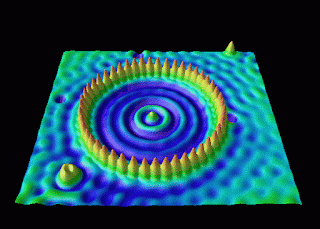 The use of nanotechnology is becoming a necessity for growth
and change within human society. Over
the history of physics and science, the idea of changing things on an atomic
level has been talked about, but it was never formed as a separate department of
science. Dr. Gimzewski states in his
lecture that Feynman, a scientist, notices that at a nanoscale, the laws of
physics change and the effects of surface tension and thermal jittering have a
larger effect than gravity at that scale. (Lecture, Part 1) The concept of
nanotechnology is knowledge that only a select few of scientist can grasp, but
the art that is conceived by the mechanics or practice of it is stunning.
The use of nanotechnology is becoming a necessity for growth
and change within human society. Over
the history of physics and science, the idea of changing things on an atomic
level has been talked about, but it was never formed as a separate department of
science. Dr. Gimzewski states in his
lecture that Feynman, a scientist, notices that at a nanoscale, the laws of
physics change and the effects of surface tension and thermal jittering have a
larger effect than gravity at that scale. (Lecture, Part 1) The concept of
nanotechnology is knowledge that only a select few of scientist can grasp, but
the art that is conceived by the mechanics or practice of it is stunning. Atoms are now being drawn or rendered due to a process
called scanning tunneling microscopy. (Lecture, Part 2) The surface of material
is changed based on changes of chemical bonds creating waves, so basically any
shape can be made on a surface. The art
potential with this scanning tunneling microscopy is only scratching the
surface because works of art can be made on surfaces that were once a different
shape or flat.
Atoms are now being drawn or rendered due to a process
called scanning tunneling microscopy. (Lecture, Part 2) The surface of material
is changed based on changes of chemical bonds creating waves, so basically any
shape can be made on a surface. The art
potential with this scanning tunneling microscopy is only scratching the
surface because works of art can be made on surfaces that were once a different
shape or flat.
Also the rendered geometric shapes of atoms can now be seen
by the same scanning process. The patterns and shapes of different atoms and
atomic structures are seen from the process and it is an achievement of science
and art. The art aspect of it is how
something that is present within nature, but cannot be seen by the naked eye,
is able to be shown to our eyes through technological advances. To be able to see what was once unknown and
mysterious is a great attribute to put on an artwork, and seeing silicon
structures and how symmetric their build in nature is achieves a work of art.
Works Cited/Links
Vesna,
Victoria. Lecture 1. DESMA
9. Web. 21 May 2015.
Vesna,
Victoria. Lecture 2. DESMA
9. Web. 21 May 2015.
"The Scanning Tunneling
Microscope." Nobel Prize. Web. 23 May 2015.
"MADE IN IBM LABS: The World's
Tiniest Art on Display." IBM. Web. 23 May 2015.
"Nanotechnology: The Art of
Molecular Carpet-weaving." ScienceDaily. ScienceDaily, 4 Jan. 2012. Web.
23 May 2015.

No comments:
Post a Comment